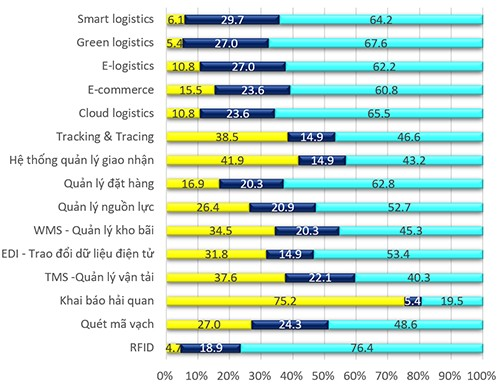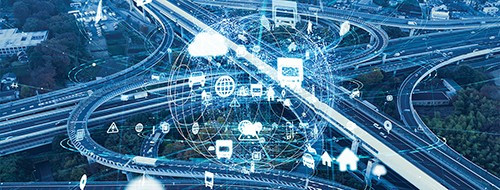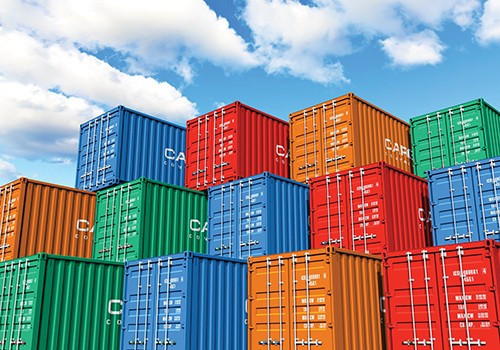Science-technology speeds up logistics developments
Hạ tầng - Ngày đăng : 22:41, 30/01/2020

Science-technology advancement being applied in logistics
Three contents of innovations that have changed logistics activities (4) include containerization, digitalization and decentralization.
Containerization
In the 1980s, containerization basically changed global cargo transport form, especially with dried cargo and general purpose cargo. Cargo was transported faster and safer with lower costs, meeting standards of logistics services.
Cargo was transported in various types of containers, suitable to different kinds of cargo: general containers, bulk containers, named containers, thermal containers, open-top containers, platform containers and tank containers. Containers have been innovated from initial ones of 8 feet, 10 feet to popular ones to popular ones of 20 feet and 40 feet today.

Trend of developing the logistics service sector in technology perspective (Source: VLA’s 2018 survey in degree and trends of developing technology)
Being developed together with containers is container vessels: from ones that were able to carry a few thousand TEU to modern and extremely large ones today. The large vessel –MSC Gulsun- has the length of nearly 400m, width of 62m and it can carry nearly 24,000 containers. On July 8th, 2019, MSC Gulsun made a journey from Tianjin, China to Europe. Previously, on February 20th, 2019, the world’s largest super container vessel Margrethe Maersk successfully anchored at Cai Mep International Terminal (CMIT) in BR-VT, which made CMIT the first port in Vietnam and the 19th in the world able to receive the generation of the world largest vessel. Margrethe Maersk- the super container vessels belonging to Maersk Line (Denmark)- has a length of 399.2m; width of 59m; gross tonnage of 194,000DWT and capacity of 18,300TEUs. The vessel has been deployed as part of the direct service between Asia and Europe within 2M alliance.
Larger and larger container vessels have been no small challenges to countries in developing deepwater seaports with modern stevedoring equipment.
To meet requirements from container vessels, especially ones with large tonnage, infrastructures as seaports, stevedoring equipment, and road transport equipment should be developed relatively. For example, Singapore is developing the mega port Tuas. It is expected to be fully automatically operated: from the system of berth cranes to unmanned fullyelectric container vehicles, which help decrease 25% of emitted gas that causes green-house effect. When completed, Tuas will be the world’s largest fullyautomated container terminal enabling to receive and handle 65 million containers of 20ft- one and a half more than capacity of Shanghai, China- the world’s current largest container terminal. Tuas project has been developed through 4 phases and it is expected the first phase will be completed in 2021. With 20 deep-water anchoring area, Tuas of its first phase is able to handle 20m container (TEU) pa. The construction will be 100% completed in 2040 and it will take a few years to reach the maximum capacity of 65m containers.
Digitalization
Digital transformation in the logistics sector closely connect to international supply chain management. The main contain is to carry out paperless procedures with the application of Electronic data interchange (EDI), carry out Automated procedures with the application of EDI based port communication system and Radio Frequency Identification (RFID) and carry out smart procedures with the use of Smart procedures with the application of Internet of things (IoT), big data, cloud computing and cyber physical systems.

Decentralization
With the main content of 3D –printers. Decentralization mainly focuses of additive manufacturing or using 3D printers. Although the printers now is in the process of developing, it can be put next to your microwave or refrigerator in the kitchen in the next 10-20 years. In the case, you can provide materials through pipes or material boxes and make your own production. In the field of logistics, logistics service provider can have new model of business, with printing products with 3D printers and deliver it at home.
Trend of developing logistics service sector in technology perspective
In situation science-technology speeds up the logistics sector developments, Vietnam logistics sector has set growth of 12%-14% and successfully achieved thanks to science-technology application and high quality manpower improvements. According to Logistics Performance Index by WB, in 2018, Vietnam was one of the top countries in newly-emerging economies, ranking 39/160 and the third in ASEAN countries, after Singapore and Thailand.
According to PwC’s reports on trend of developments of the transport and logistics sector, in 5 factors that change the sector: digitalization, changes in international trade, changes of software management process, changes in local trade market, and changes in control machine process, there are 3 of them relating to technology and digitalization that are ripe and have strong impacts to the sector.
Digitalize changed all sectors of transport and logistics and it is expected to be the trend with most impacts in years to come that reshape all business.
VLA have been actively carrying out sciencetechonology activities, creating a platform to share and to exchange data to all related sides in the supply chain, connecting cargo transaction floors to optimize the use of cargo vihicles, to reduce logistics costs, to apply block chain technology in e-Delivery Order, and taking part in projects of constructing digital ecosystem as e-Bill of Lading by FIATA…

And we can come up with a conclusion: sciencetechnology is both driving force and important factor to speed up logistics service developments. Together with high quality man power, science-technology creates spare grounds for the logistics service and world digital economy to develop in the period of the Industry 4.0.
